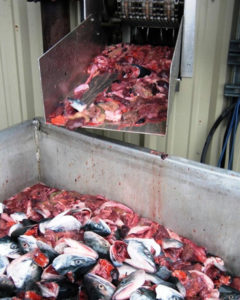NOAA, USDA form Alternative Feeds Initiative

Rising global demand for fishmeal and fish oil and a renewed push to maintain the sustainability of the pelagic fisheries that supply these products to the global swine, poultry, pet and fish-farming industries are driving the need for alternatives to fishmeal and fish oil.
In the United States, experts in federal agencies, universities and private industry are developing a variety of alternative protein and oil sources, including soybeans, barley, rice, peas, canola, lupine, wheat gluten, corn gluten and other plant products. Researchers also are examining the use of trimmings from seafood processing, waste from bioenergy production, insects grown on waste materials and algae as potential alternatives.
“The biggest challenge for our researchers is to develop alternative ingredients that fish will eat, that supply the nutrition fish require to grow and that can become commercially viable,” said Dr. Michael Rubino, Aquaculture Program manager at the National Oceanic and Atmospheric Administration (NOAA), one of the key federal agencies working on alternative feeds. “Ultimately, these research efforts will lead to the commercialization of alternatives that will reduce dependence on marine fish resources by feed manufacturers and seafood farmers worldwide.”
Alternative feeds initiative
The two U.S. federal agencies with ongoing alternative feeds research programs, NOAA and the U.S. Department of Agriculture (USDA), joined forces in late 2007 to form the NOAA-USDA Alternative Feeds Initiative. The goal of the initiative is to identify alternative ingredients that will reduce the amount of fishmeal and fish oil in aquaculture feeds while maintaining the human health benefits of seafood. USDA’s Agricultural Research Service and Cooperative State Research, Education and Extension Service are the USDA agencies involved in the initiative.
The NOAA-USDA initiative got off to a fast start in early 2008, when the agencies convened a panel of U.S. and international researchers to gauge the state of alternative feeds research and identify new research priorities. At the same time, the agencies solicited ideas and suggestions through a public comment process.
In April 2008, the agencies convened the NOAA-USDA Alternative Feeds Initiative Stakeholder Meeting to provide a forum for open communication among stakeholders and interactive dialogue focused on current and best-available knowledge of promising alternative feed ingredients.
Feedstuffs session
In mid-February, NOAA, USDA and the independent Plant Products in Aquafeeds (PPA) Working Group co-sponsored a joint technical session titled “Alternative Feedstuffs for Aquaculture” at the Aquaculture America meeting in Seattle, Washington, USA, the largest annual aquaculture conference and exposition in the United States.
At the all-day session, over 100 participants from the U.S., Norway, Central America, Spain, Nigeria, Japan and Australia listened to the presentations and participated in panel sessions on everything from new studies addressing the use of alternative animal and plant proteins and animal by-products to digestibility, genetics, enhancing nutritive values and diet formulation.
Feed workshop
Also in February, Dr. Michael Rust of the NOAA Northwest Fisheries Science Center hosted a workshop on alternative feeds at the annual Seafood Choices Summit in San Diego, California, USA. The workshop, which featured speakers from EWOS and Troutlodge, attracted a cross section of representatives of the seafood marketing and processing industries, aquafeed manufacturers, environmental NGOs and seafood retailers.
“There are a wide variety of meals available that can provide what is needed by fish from a nutritional standpoint,” Rust said. “The key to getting these materials from the fish nutrition labs to the feed mills is making sure that they are economically competitive, have an acceptable environmental footprint and maintain the taste, texture and healthful nutrients that seafood is famous for.”
The next step for the NOAA-USDA initiative will be the release of a draft white paper summarizing the results of the researcher and stakeholder meetings and highlighting recent research advances.
(Editor’s Note: This article was originally published in the July/August 2009 print edition of the Global Aquaculture Advocate.)
Now that you've finished reading the article ...
… we hope you’ll consider supporting our mission to document the evolution of the global aquaculture industry and share our vast network of contributors’ expansive knowledge every week.
By becoming a Global Seafood Alliance member, you’re ensuring that all of the pre-competitive work we do through member benefits, resources and events can continue. Individual membership costs just $50 a year. GSA individual and corporate members receive complimentary access to a series of GOAL virtual events beginning in April. Join now.
Not a GSA member? Join us.
Author
-
Chris Botnick
Outreach Specialist
NOAA Aquaculture Program
1315 East-West Highway SSMC 3
Mail Code F
Silver Spring, Maryland, 20910 USA
Tagged With
Related Posts

Aquafeeds
A look at corn distillers dried grains with solubles
Corn distillers dried grains with solubles are an economical source of energy, protein and digestible phosphorus to reduce feed costs and fishmeal usage.

Aquafeeds
A look at protease enzymes in crustacean nutrition
Food digestion involves digestive enzymes to break down polymeric macromolecules and facilitate nutrient absorption. Enzyme supplementation in aquafeeds is a major alternative to improve feed quality and nutrient digestibility, gut health, compensate digestive enzymes when needed, and may also improve immune responses.

Aquafeeds
A new nutrient for aquaculture, from microbes that consume carbon waste
Biotechnology firm NovoNutrients aims to produce a line of nutraceutical aquafeed additives as well as a bulk feed ingredient that can supplement fishmeal. Its process includes feeding carbon dioxide from industrial gas to a “microbial consortium” starring hydrogen-oxidizing bacteria.

Aquafeeds
Algae alternative: Chlorella studied as protein source in tilapia feeds
Chlorella and other species have potential as protein sources in aquafeeds. In trials with tilapia fry raised in a recirculating system, the fish received a fishmeal-based control diet or feeds with portions of the fishmeal replaced by Chlorella.


